By Shafaq Sultana1, Talea Hoor2, Madiha Ata1
- Department of Health Professionals Education, Indus University of health sciences, The Indus Hospital and Health Network, Karachi, Pakistan
- Department of Pharmacology, Bahria University Health Sciences, Karachi, Pakistan
DOI: https://doi.org/10.36283/PJMD12-3/008
How to cite: Sultana S, Hoor T, Ata M. Flipped Classroom Learning among Medical and Dental Faculty of BUMDC. Pak J Med Dent. 2023;12(3): 42-48. doi: 10.36283/PJMD12-3/008
Background: Flipped classroom technique (FCR) is a pedagogical approach where students watch pre-recorded video lectures or read educational materials before coming to class. During class, students engage in activities, discussions, and problem-solving exercises related to the pre-recorded content, with the teacher acting as a facilitator and guide. The key to the effective utilization of this instructional method is that both the teachers and the students understand its educational philosophy and technique. This study aims at exploring the faculty’s understanding and perceptions regarding flipping the classroom.
Method: A Cross-sectional Descriptive study was carried out at Bahria university medical and dental college (BUMDC), Karachi, Pakistan from January to June 2020, after approval from the institutional ethical review committee. Data was collected through a self-designed questionnaire after obtaining verbal consent from 197 faculty members through non-probability purposive sampling. Data were analyzed by version 23.0 of Statistical Package for Social Sciences (SPSS). The mean scores of these identified factors were compared between genders, departments, designations, and teaching experience using an independent sample t-test and one-way ANOVA. P-values less than 0.05 were considered statistically significant.
Results: The results revealed that more than half of the studied participants had a moderate perception regarding Flipped Classroom and more than one-third of those who were female (67.5%), had a highly positive perception (<0.01). According to designation and teaching experience, mean scores were higher for senior faculty as compared to junior faculty (p=0.02).
Conclusions: Contrary to popular belief, senior faculty also perceives this new technique as being beneficial for their teaching. This opportunity should be utilized to train the faculty in conducting flipped classrooms in order to optimize its benefits.
Keywords: Education, Faculty, Medical Students, Learning.
The competencies of teaching and developing teaching-learning material are integral to the functioning of qualified health professional teachers. The concept of flipping the class is still in its early stages. It was introduced by two American educators in 2007 when they started recording their lectures so that students could access them outside the classroom preferably at their homes1. Since then, it has evolved as a well-recognized pedagogical learning approach in which students are engaged in the learning process prior to attending the main large group session or lecture. Hence, the focus of learning is shifted from large group learning to individual learning followed by facilitation in the application and analysis of the concept by a teacher in classroom sessions2.
This methodology; which is a reverse of the traditional approach, enhances motivation and provides a practical and effective attitude, and makes educational improvement possible since it frees up teacher instructional time3. It utilizes readily accessible technology-based resources such as video lectures, reading handouts, and practice problems outside the classroom, whereas interactive group-based, problem-solving activities are conducted in the classroom. This method helps to utilize in-class time for active learning, peer-to-peer interaction, and collaboration4.
Faculty perception plays a crucial role in the successful implementation of the flipped classroom approach in education. Faculty members are the ones who design and deliver the learning experiences, and their buy-in and understanding of the flipped classroom model can significantly impact the success of the implementation5. Positive faculty perception can lead to increased motivation and engagement, resulting in more effective implementation of the flipped classroom approach6. When faculty members are supportive of the approach, they are more likely to invest time and effort in developing high-quality learning materials and implementing engaging in-class activities that complement the pre-recorded content7. On the other hand, negative faculty perception can create barriers to implementation, leading to less engagement and lower quality implementation. If faculty members are not convinced of the value of the flipped classroom approach or are not comfortable with the shift in their traditional teaching roles, they may not invest the necessary effort or time needed to make the flipped classroom approach successful.8
Therefore, it is essential to consider the perceptions and attitudes of faculty members towards the flipped classroom approach when designing training programs and implementing the model in educational institutions9. In order to establish its optimal utility, this study aimed to explore the levels of understanding and the perceptions of medical and dental faculty members; at different levels of their careers, about flipped classroom model.
A Cross-sectional Descriptive study was carried out at Bahria university medical and dental college (BUMDC), Karachi, Pakistan from January to June 2020, after approval from the institutional ethical review committee (FRC-BUMDC01/2020). Using open epi sample size calculator version 3.01, after assuming 50% expected positive perceptions for the flipped classroom at a 7% margin of error and 95% confidence interval, the sample size was calculated as 196. Non-probability purposive sampling technique was used to enroll the participants for the study.
Based on a review of the literature, a self-administered questionnaire was created10. The questionnaire featured 27 items that were focused on determining how professors felt about flipped classrooms. The replies were scored using a 5-level Likert scale. All medical and dental faculty members were included in the study, and those who refused to participate or returned the questionnaire with blanks or incomplete information were disqualified. Each participant was asked for their informed consent.
Version 23.0 of SPSS was used to store and analyze the data. For respondents’ baseline characteristics, such as gender, department, designation, and teaching experience, frequencies with percentages were presented. Also, a descriptive analysis of the items was conducted, and Cronbach’s alpha was used to assess the reliability of the questionnaire which came to be 0.76%11.
A multivariate tool factor analysis was done on the 26 items of the questionnaire to identify the impact of the flipped classrooms on students, faculty, and university separately through the faculty perception. The mean scores of these identified factors were compared between genders, departments, designations, and teaching experience using an independent sample t-test and one-way ANOVA. P-values less than 0.05 were considered statistically significant.
The baseline characteristics of participants are shown in Table 1. The majority of the participants 67.5% (133) were female, belonging to basic health sciences 58.9 % (116).
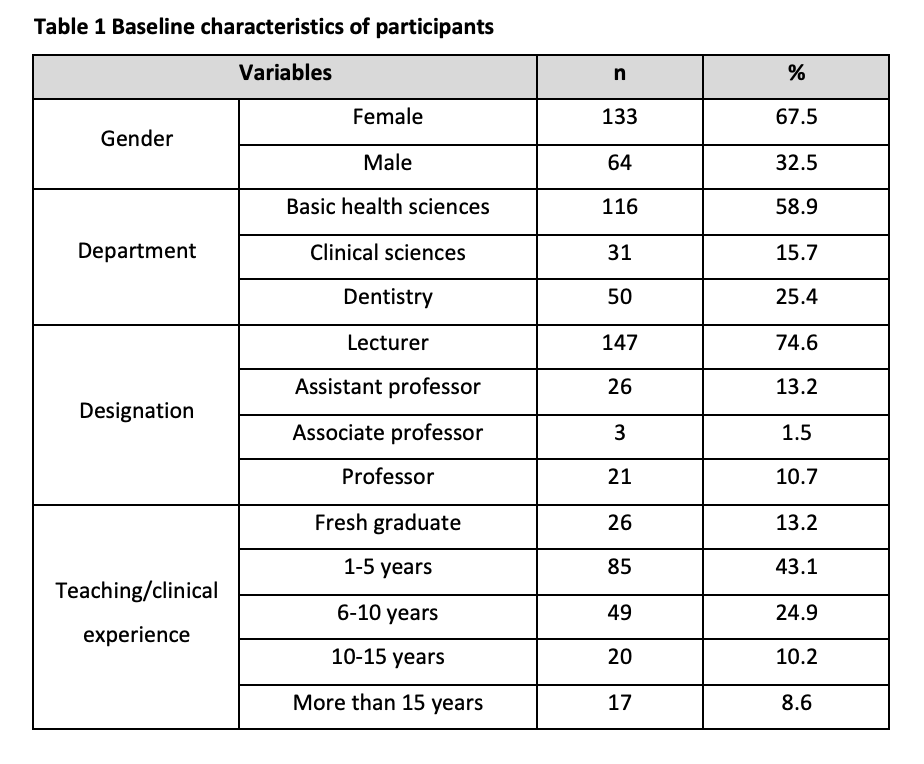
The perceptions of the faculty and their understanding of the new teaching methodology have been divided into 3 broad categories shown in Table 2 and Figure 1. For the items relating to the structure of the session, most received the highest response in the ‘agree’ category except for ‘single session usage’ for which the highest response percentage was 30.5% which was for ‘disagree’. Regarding the strategy involved in FCR teaching, 50.3% agreed that successful FCR depends on the organization of course material and 44.7% agreed that this strategy addresses gaps in knowledge. The items related to the feedback of the session revealed that 43.1% agreed that immediate feedback on misconceptions can be provided during class time. 43.1% agreed on group discussions are encouraged by this methodology, and 45.2% agreed on this strategy promotes the collaborative application of knowledge, feedback, and evaluation.
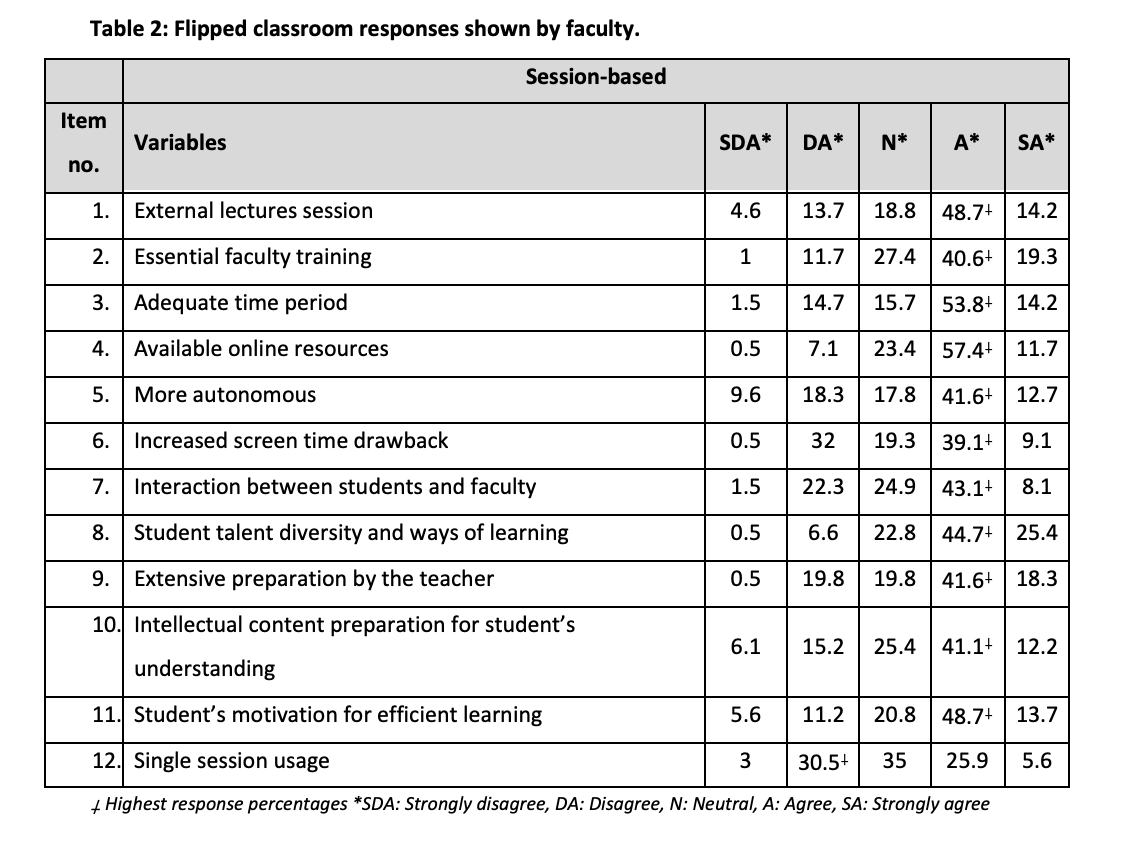
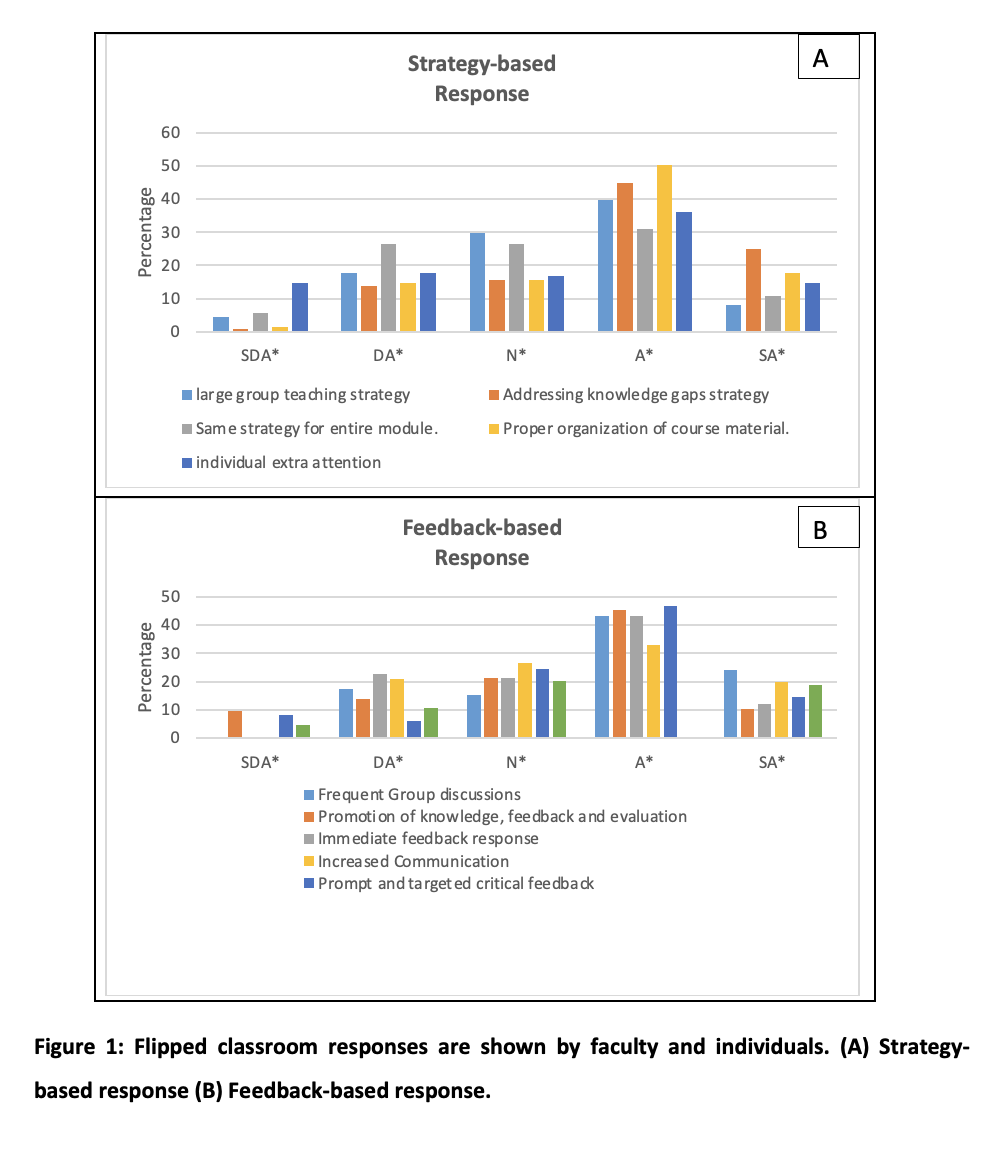
The Scree plot showed there were three major factors that were extracted for the implementation of FCR. The first theme was labeled as the impact on students while implementing flip classrooms with an 18.5% variation in data. The second theme was the impact on faculty which showed an 8% variation in data and the third theme was the impact on the university which explained a 7.2% variation in data. Hence more than 33% variation was explained by these three extracted themes. The higher coefficient showed a higher load of items for the extracted factor (Figure 2).
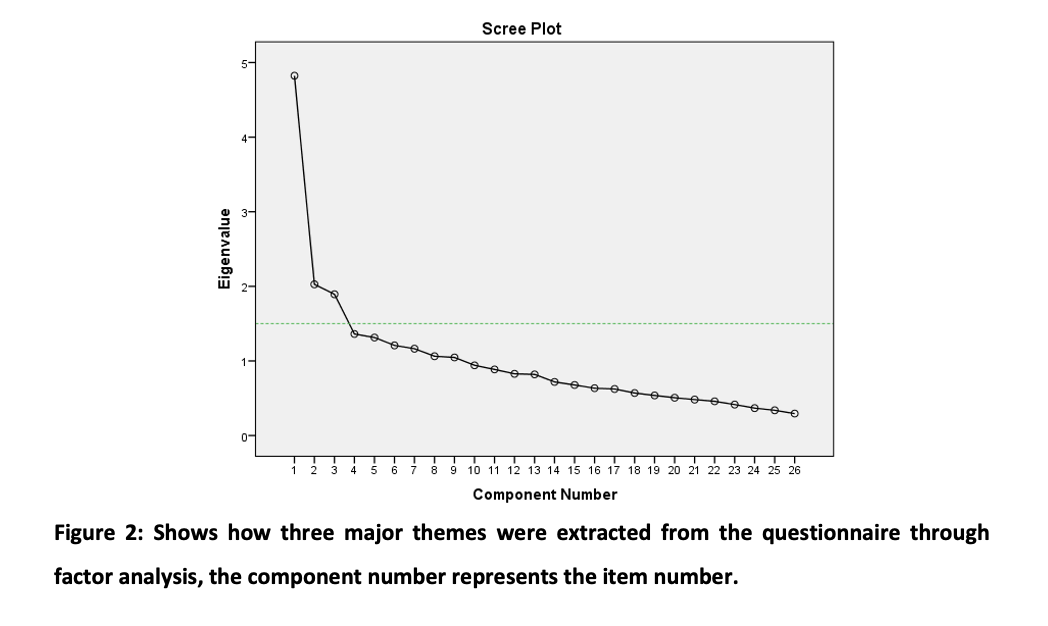
The coefficient matrix of items extracted using principal component factor analysis, the significant p-value of KMO- and Bartlett’s test suggested that factor analysis was a suitable tool to extract the factors for FCR. (Data not shown)
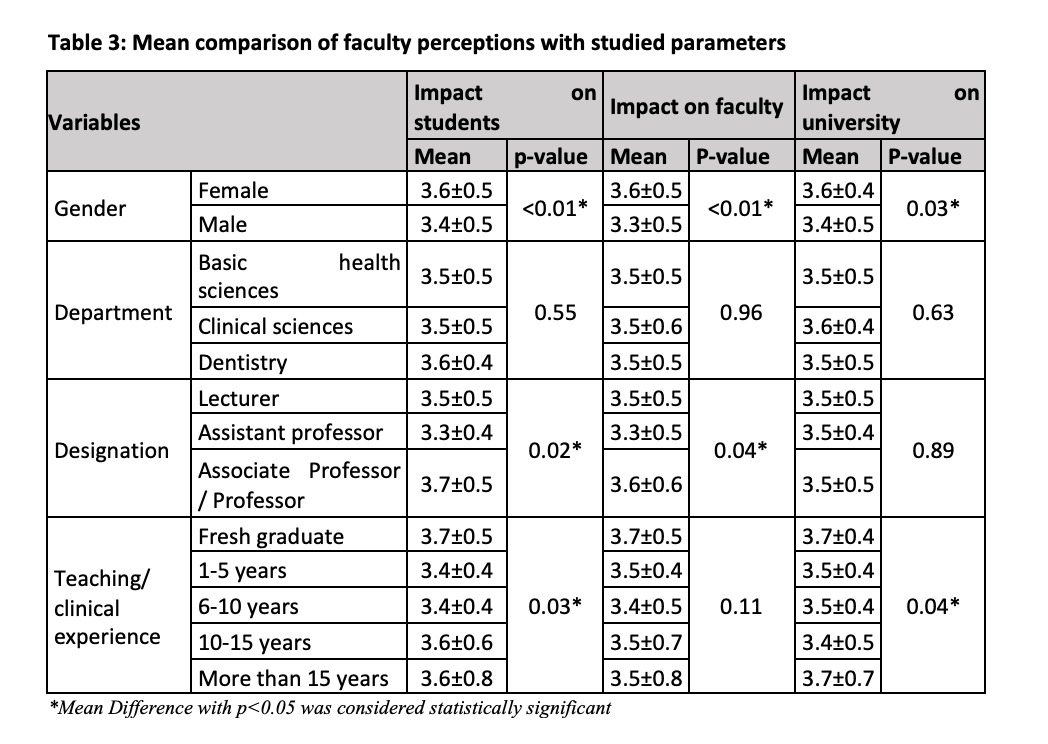
Table-3 gives the comparison of mean scores of extracted factors with respect to studied parameters. For impact on the student, females have significantly higher mean scores as compared to male samples, all department on average have the same mean scores, however, mean scores for impact on faculty vary significantly with respect to designation and teaching experience, upper faculty level and seniors have higher mean scores for impact on faculty. For impact on faculty gender and designation whereas for impact on university gender and teaching experience gives significant mean differences for the identified factors with p-value less than 0.05.
Several studies have been conducted on the benefits and limitations of flipped classrooms12,13. However, there is scanty data on the perception of teachers at different levels of their experience who prepare and conduct these classes. Thus, the present study evaluated the difference in perception and opinions regarding flipped classrooms as an effective learning and teaching strategy of the faculty of BUMDC. Our results revealed that more than half of the studied participants had a moderate perception of Flipped Classroom and more than one-third of those, who were female, had a highly positive perception of FC. The majority of our participants were females; 67.5% (133) and most of them belonged to basic health sciences. This can be explained by the fact that the sample was collected through the purposive convenience method, resulting in more data collection from the in-house faculty14.
Our study found that the faculty did not perceive this technique to require extensive resources; this is in contrast to the findings of a study that found that the lack of resources and infrastructure is viewed as a major hindrance to the implementation of flipped classroom technique15. 57.4% (113) of the participants did agree that it requires extra effort to create online resources and 41.6% (81.9%) thought it needed the teacher to spend a lot of time preparing for class when using this technique. This perception is not unexpected as it is well recognized by the educators such as Snowden6. This concern has adequately been addressed in the twelve tips for flipped classrooms, where it is suggested that the faculty should be reassured that this is a one-time effort that promises to go a long way10.
Most of the participants either strongly agreed or agreed to the questions regarding the effectiveness of this strategy in encouraging collaborative knowledge application and in motivating the students to generate, direct, and sustain their learning in a more effective way.16 This understanding of the faculty is expected to reflect positively during the implementation of the flipped classroom. These positive perceptions are in agreement with several existing studies4,17,18. Effective feedback is recognized as an essential component of the teaching and learning cycle19. Most of the teachers in our study had a positive response to the questions related to feedback; 55.3% and 61.4% (109 and 120). This advantage of flipped classrooms has been recognized in previous studies as well19,20.
Factor analysis of our results revealed that the faculty perceived it as an impactful tool in three broad domains, namely faculty, students, and the university. The younger faculty members (fresh graduates) were significantly more aware of the widespread impact of flipped classroom techniques on the students and the university. This may be attributed to them being more comfortable with the use of technology and with change.21 No studies have made any such deductions in the past.22 A remarkable finding from our study was that females and senior faculty had more positive perceptions regarding the effect of flipped classroom technique on the faculty and the students. This goes against the infamous ‘technological gender gap’, where females have been linked with poor levels of confidence, performance, and acceptance when faced with the use of technology23.
However, some existing studies are in concordance with our findings too, where female faculty members have shown a more favorable perception of flipped technique24. Our findings also negate the common perception that senior faculty members are resistant to change and refuse the accept the benefits of new approaches25.
The faculty at all levels of experience showed positive perceptions regarding flipped classroom technique. Based on the findings of this study, academic institutions ought to emphasize the value of flipping the classroom and introducing it at all levels. The faculty members’ understanding and perceptions of this teaching strategy can be further enhanced through faculty training sessions. This will help to enhance the quality of instruction and the delivery of learning material. To apply this teaching style in their institutes, the faculty, students, and administration must collaborate to identify the implementation obstacles and then work together to address them.
The authors acknowledge Mr. Imran Shekhani, research assistant for his constant support.
All the authors hereby declare that there is no conflict of interest.
This study was approved by the Bahria University institutional ethical review committee (FRC-BUMDC01/2020).
Verbal consent was obtained from the participants of the study.
All authors contributed equally to this research write-up.
- Bergmann J, Sams A. Before you flip, consider this. Phi Delta Kappan. 2012;94(2):25-27.doi:10.1177/003172171209400206
- Gonda D, Pavlovičová G, Tirpáková A, Ďuriš V. Setting up a flipped classroom design to reduce student academic procrastination. Sustain Sci 2021;13(15):8668. doi:10.3390/su13158668
- Hong H, Jung Y-E. Review of effective instructional methods for medical education: focusing on flipped learning. J Med Life Sci. 2020;17(1):1-6. doi:10.22730/jmls.2020.17.1.1
- Mendaña-Cuervo C, Poy-Castro R, López-González E. Metodología flipped classroom: Percepción de los alumnos de diferentes grados universitarios. Inno Int J Tech Educ Inno. 2019;5(2):178-188. doi:10.24310/innoeduca.2019.v5i2.5223
- Shehata MH, Abouzeid E, Wasfy NF, Abdelaziz A, Wells RL, Ahmed SA. Medical education adaptations post COVID-19: an Egyptian reflection. J. med. educ. curric. dev.. 2020;7:2382120520951819.
- Göçen A, Eral SH, Bücük MH. Teacher perceptions of a 21st century classroom. Int J Contemp Educ Res. 2020;7(1):85-98. doi: 10.33200/ijcer.638110
- Ozudogru M, Aksu M. Pre-service teachers’ achievement and perceptions of the classroom environment in flipped learning and traditional instruction classes. Australas J Educ Technol 2020;36(4):27-43. doi:10.14742/ajet.5115
- Bingen HM, Steindal SA, Krumsvik R, Tveit B. Nursing students studying physiology within a flipped classroom, self-regulation and off-campus activities. Nurse Educ Pract. 2019;35:55-62. doi: 10.1016/j.nepr.2019.01.004
- Hyypiä M, Sointu E, Hirsto L, Valtonen T. Key components of learning environments in creating a positive flipped classroom course experience. Int J Learn Teach Educ. 2019. doi:10.26803/ijlter.18.13.4
- Moffett J. Twelve tips for “flipping” the classroom. Med Teach 2014;37(4):331-336. doi:10.3109/0142159X.2014.943710
- Schrepp M. On the Usage of Cronbach’s Alpha to Measure Reliability of UX Scales. J Usability Stud. 2020;15(4).
- Divjak B, Rienties B, Iniesto F, Vondra P, Žižak M. Flipped classrooms in higher education during the COVID-19 pandemic: Findings and future research recommendations. Int J Educ Technol High Educ. 2022;19(1):1-24. doi: 10.1186/s41239-021-00316-4
- Rodríguez G, Díez J, Pérez N, Baños J-E, Carrió M. Flipped classroom: Fostering creative skills in undergraduate students of health sciences. Think Skills Creat 2019;33:100575. doi:org/10.1016/j.tsc.2019.100575
- Sharma M. Applying feminist theory to medical education. Lancet.2019;393(10171):570-578. doi: 10.1016/S0140-6736(18)32595-9
- Aidoo B, Vesterinen V-M, Macdonald MA, Gísladóttir B, Pétursdóttir S. Perceptions of Ghanaian Student Teachers on Benefits and Challenges of the Flipped Classroom: A Case Study. Contemp Educ Technol. 2022;14(4):ep377. doi: 10.30935/cedtech/12163
- Turan Z, Akdag-Cimen B. Flipped classroom in English language teaching: a systematic review. Comput Assist Lang Learn. 2020;33(5-6):590-60. doi:10.1080/09588221.2019.1584117
- García-Gil D, Cremades-Andreu R. ” Flipped classroom” en educación superior. Un estudio a través de relatos de alumnos. Rev Mex Investig Educ. 2019;24(80):101-123.
- Samuel ML. Flipped pedagogy and student evaluations of teaching. Active Learn High Educ. 2021;22(2):159-168. doi:10.1177/1469787419855
- Watling CJ, Ginsburg S. Assessment, feedback and the alchemy of learning. Med Educ. 2019;53(1):76-85. doi:10.1111/medu.13645
- Oudbier J, Spaai G, Timmermans K, Boerboom T. Enhancing the effectiveness of flipped classroom in health science education: a state-of-the-art review. BMC Med. 2022;22(1):1-15. doi:10.1186/s12909-021-03052-5
- Naziman Y, Aznan NFM, Ab Rahman SM, Nor NHM, Idrus S. Fostering the usage of flipped classroom: The conceptual framework. Nat Acad Manag Staff Cultu Art Her 2018;1:1189-1194. doi:10.14419/ijet.v7i4.38.27822
- Schroth H. Are you ready for Gen Z in the workplace? Calif Manage Rev 2019;61(3):5-18. doi:10.1177/0008125619841006
- Wong SL, Hanafi A. Gender differences in attitudes towards information technology among Malaysian student teachers: A case study at Universiti Putra Malaysia. J Educ Technol. 2007;10(2):158-169.
- Abuhmaid AM. Teachers’ perceptions on the impact of flipped learning on student learning and teacher’s role in Jordanian Schools. Univers J Educ. 2020;8(3):1007-1016. doi:10.13189/ujer.2020.080335
- Shehata MH, Abouzeid E, Wasfy NF, Abdelaziz A, Wells RL, Ahmed SA. Medical Education Adaptations Post COVID-19: An Egyptian Reflection. J Med Educ Curric Dev. 2020;7:2382120520951819. doi: 10.1177/2382120520951819.
This is an open-access article distributed under the terms of the CreativeCommons Attribution License (CC BY) 4.0 https://creativecommons.org/licenses/by/4.0/
